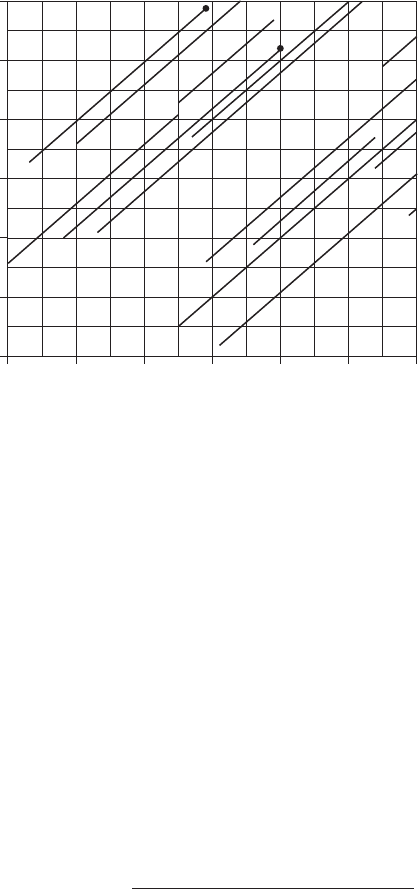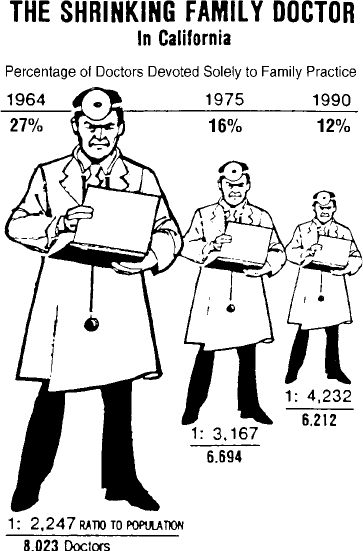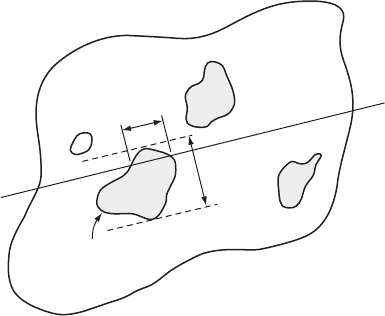Everitt B.S. The Cambridge Dictionary of Statistics
Подождите немного. Документ загружается.


Liapu no v, Alexa nder Mi kha i l o vich ( 1857^1 918) : Born in Yaroslavl, Russia, Liapunov
attended Saint Petersburg University from 1876 where he worked under
Chebyshev
.In
1885 he was appointed to Kharkov University to teach mechanics and then in 1902 he left
Kharkov for St. Petersburg on his election to the Academy of Sciences. Liapunov made
major contributions to probability theory. He died on November 3rd, 1918 in Odessa, USSR.
Liddell, Francis Douglas Kelly (1924^20 03): Liddell was educated at Manchester Grammar
School from where he won a scholarship to Trinity College, Cambridge, to study mathematics. He
graduated in 1945 and was drafted into the Admiralty to work on the design and testing of naval
mines. In 1947 he joined the National Coal Board where in his 21 years he progressed from
ScientificOfficer to Head of the Mathematical Statistics Branch. In 1969 Liddell moved to the
Department of Epidemio logy at McGill University, where he remained until his retirement in
1992. Liddell contributed to the statistical aspects of investigations of occupational health,
particularly exposure to coal, silica and asbestos. He died in Wimbled on, London, on 5 June 2003.
Lie factor: A quantity suggested by Tufte for judging the honesty of a graphical presentation of data.
Calculated as
apparent size of effect shown in graph
actual size of effect in data
Values close to one are desirable but it is not uncommon to find values close to zero and greater
than five. The example shown in Fig. 87 has a lie factor of about 2.8. [The Visual Display of
Quantitative Information, 1983, E.R. Tufte, Graphics Press, Cheshire, Connecticut.]
Life expectancy: The expected number of years remaining to be lived by persons of a particular
age. Estimated life expectancies at birth for a number of countries in 2008 are as follows:
Country Life expectancy at birth (years)
Japan 82.67
Iceland 80.43
United Kingdom 78.70
Afghanistan 43.77
60
50
40
15
3
16
10
6
1
9
7
12
14
1
5
16
10
11
2
17
8
15
8
30
20
10
0
1940 1950 1960 1970
Calendar time
Age
1980 1990 2000
Fig. 86 A Lexis diagram showing age and calendar period.
249

Li fe table: A procedure used to compute chances of survival and death and remaining years of life, for
specific years of age. An example of part of such a table is as follows:
Life table for white females, United States, 1949–1951
12 3 4 5 6 7
0 23.55 100000 2355 97965 7203179 72.03
1 1.89 97465 185 97552 7105214 72.77
2 1.12 97460 109 97406 7007662 71.90
3 0.87 97351 85 97308 6910256 70.98
4 0.69 92266 67 97233 6812948 70.04
⋮⋮ ⋮ ⋮ ⋮ ⋮ ⋮
100 388.39 294 114 237 566 1.92
1 = Year of age
2 = Death rate per 1000
3 = Number surviving of 100 000 born alive
4 = Number dying of 100 000 born alive
5 = Number of years lived by cohort
6 = Total number of years lived by cohort until all have died
7 = Average future years of life
[SMR Chapter 13.]
Li fe table ana lysis: A procedure often applied in
prospective studies
to examine the distribution of
mortality and/or morbidity in one or more diseases in a
cohort study
of patients over a fixed
period of time. For each specific increment in the follow-up period, the number entering the
period, the number leaving during the period, and the number either dying from the disease
Fig. 87 A diagram with a lie factor
of 2.8.
250

(mortality) or developing the disease (morbidity), are all calculated. It is assumed that an
individual not completing the follow-up period is exposed for half this period, thus enabling
the data for those ‘leaving’ and those ‘staying’ to be combined into an appropriate denom-
inator for the estimation of the percentage dying from or developing the disease. The
advantage of this approach is that all patients, not only those who have been involved for
an extended period, can be be included in the estimation process. See also actuarial
estimator [SMR Chapter 13.]
Li fti ng scheme: A method for constructing new wavelets with prescribed properties for use in
wavelet analysis
.[SIAM Journal of Mathematical Analysis, 1998, 29,511–546.]
Likel ih ood: The probability of a set of observations given the value of some parameter or set of
parameters. For example, the likelihood of a random sample of n observations, x
1
; x
2
; ...; x
n
with probability distribution, f(x,θ) is given by
L ¼
Y
n
i¼1
f ðx
i
;Þ
This function is the basis of
maximum likelihood estimation
. In many applications the likelihood
involves several parameters, only a few of which are of interest to the investigator. The remaining
nuisance parameters
are necessary in order that the model make sense physically, but their
values are largely irrelevant to the investigation and the conclusions to be drawn. Since there are
difficulties in dealing with likelihoods that depend on a large number of incidental parameters
(for example, maximizing the likelihood will be more difficult) some form of modified
likelihood is sought which contains as few of the uninteresting parameters as possible. A number
of possibilities are available. For example, the marginal likelihood, eliminates the nuisance
parameters by integrating them out of the likelihood. The profile likelihood with respect to
the parameters of interest, is the original likelihood, partially maximized with respect to
the nuisance parameters. See also quasi-likelihood, pseudo-likelihood, partial likelihood,
hierarchical likelihood, conditional likelihood, law of likelihood and likelihood ratio.
[KA2 Chapter 17.]
Likelihooddistancetest: A procedure for the detection of
outliers
that uses the difference between
the
log-likelihood
of the complete data set and the log-likelihood when a particular obser-
vation is removed. If the difference is large then the observation involved is considered an
outlier. [Statistical Inference Based on the Likelihood, 1996, A. Azzalini, CRC/Chapman
and Hall, London.]
Likelihood principle: Within the framework of a statistical model, all the information which the data
provide concerning the relative merits of two hypotheses is contained in the
likelihood ratio
of these hypotheses on the data. [Likelihood, 1992, A. W. F. Edwards, Cambridge University
Press, Cambridge.]
Likel ih oodrati o test: The ratio of the
likelihoods
of the data under two hypotheses, H
0
and H
1
, can
be used to assess H
0
against H
1
since under H
0
, the statistic, λ, given by
l ¼2ln
L
H
0
L
H
1
has approximately a
chi-squared distribution
with degrees of freedom equal to the difference
in the number of parameters in the two hypotheses. See also Wilks’ theorem G
2
, deviance,
goodness-of-fit and Bartlett’s adjustment factor. [KA2 Chapter 23.]
Lik ert, R ensis ( 1903^1981) : Likert was born in Cheyenne, Wyoming and studied civil engineering
and sociology at the University of Michigan. In 1932 he obtained a Ph.D. at Columbia
251
University’s Department of Psychology. His doctoral research dealt with the measurement of
attitudes. Likert’s work made a tremendous impact on social statistics and he received many
honours, including being made President of the American Statistical Association in 1959.
Likert scales: Scales often used in studies of attitudes in which the raw scores are based on graded
alternative responses to each of a series of questions. For example, the subject may be asked
to indicate his/her degree of agreement with each of a series of statements relevant to the
attitude. A number is attached to each possible response, e.g. 1:strongly approve; 2:approve;
3:undecided; 4:disapprove; 5:strongly disapprove; and the sum of these used as the compo-
site score. A commonly used Likert-type scale in medicine is the Apgar score used to
appraise the status of newborn infants. This is the sum of the points (0,1 or 2) allotted for
each of five items:
*
heart rate (over 100 beats per minute 2 points, slower 1 point, no beat 0);
*
respiratory effort;
*
muscle tone;
*
response to simulation by a catheter in the nostril;
*
skin colour.
[Scale Development: Theory and Applications, 1991, R. F. DeVellis, Sage, Newbury Park.]
Lilliefors test: A test used to assess whether data arise from a normally distributed population where
the mean and the variance of the population are not specified. See also Kolmogorov-
Smirnov test.[Journal of the American Statistical Association, 1967, 62, 399–402.]
Lim^Wolfe test: A rank based multiple test procedure for identifying the dose levels that are more
effective than the zero-dose control in
randomized block designs
, when it can be assumed
that the efficacy of the increasing dose levels in monotonically increasing up to a point,
followed by a monotonic decrease. [Biometrics, 1997, 53, 410–18.]
Li nd l ey’sparadox: A name used for situations where using
Bayesian inference
suggests very large
odds in favour of some null hypothesis when a standard sampling-theory test of significance
indicates very strong evidence against it. [Biometrika, 1957, 44, 187–92.]
Linear birth process: Synonym for Yule–Furry process.
Linear-by-linear association test: A test for detecting specific types of departure from inde-
pendence in a
contingency table
in which both the row and column categories have a natural
order. See also Jonckheere–Terpstra test.[The Analysis of Contingency Tables, 2nd
edition, 1992, B. S. Everitt, Chapman and Hall/CRC Press, London.]
Li near-ci rcu l a r corre lat i on: A measure of correlation between an interval scaled random variable
X and a
circular random variable
, Θ, lying in the interval (0,2π). For example, X may refer to
temperature and Θ to wind direction. The measure is given by
2
X
¼ð
2
12
þ
2
13
2
12
13
23
Þ=ð1
2
23
Þ
where
12
¼ corrðX ; cos Þ;
13
¼ corrðX ; sin Þand
23
¼ corrðcos ; sin Þ. The sam-
ple quantity R
2
x
is obtained by replacing the ρ
ij
by the sample coefficients r
ij
.[Biometrika,
1976, 63, 403 –5.]
Li near est i mator: An estimator which is a linear function of the observations, or of sample statistics
calculated from the observations.
Linear filters: Suppose a series {x
t
} is passed into a ‘black box’ which produces {y
t
} as output. If the
following two restrictions are introduced: (1) The relationship is linear; (2) The relationship
252

is invariant over time, then for any t, y
t
is a weighted linear combination of past and future
values of the input
y
t
¼
X
1
j¼1
a
j
x
tj
with
X
1
j¼1
a
2
j
5
1
It is this relationship which is known as a linear filter. If the input series has power spectrum
h
x
(ω) and the output a corresponding spectrum h
y
(ω), they are related by
h
y
ðωÞ¼
X
1
j¼1
a
j
e
iωj
2
h
x
ðωÞ
if we write h
y
ðωÞ¼jðωÞj
2
h
x
ðωÞ where ðωÞ¼
P
1
j¼1
a
j
e
ijω
, then ðωÞ is called the
transfer function while j ð ωÞis called the amplitude gain. The squared value is known as the
gain or the power transfer function of the filter. [TMS Chapter 2.]
Li near functi o n: A function of a set of variables, parameters, etc., that does not contain powers or
cross-products of the quantities. For example, the following are all such functions of three
variables, x
1
,x
2
and x
3
,
y ¼ x
1
þ 2x
2
þ x
3
z ¼ 6x
1
x
3
w ¼ 0:34x
1
2:4x
2
þ 12x
3
Li n ea r izing: The conversion of a
non-linear model
into one that is linear, for the purpose of simplify-
ing the estimation of parameters. A common example of the use of the procedure is in
association with the Michaelis–Menten equation
B ¼
B
max
F
K
D
þ F
where B and F are the concentrations of bound and free ligand at equilibrium, and the two
parameters, B
max
and K
D
are known as capacity and affinity. This equation can be reduced to
a linear form in a number of ways, for example
1
B
¼
1
B
max
þ
K
D
B
max
1
F
is linear in terms of the variables 1/B and 1/F. The resulting linear equation is known as the
Lineweaver–Burk equation.
Linear logistic regression: Synonym for logistic regression.
Linearly separable: A term applied to two groups of observations when there is a linear function of a
set of variables x
0
¼½x
1
; x
2
; ...; x
q
, say, x
0
a þb which is positive for one group and
negative for the other. See also discriminant function analysis and Fisher’s linear
discriminant function.[Pattern Recognition,1979,11,109–114]
Linear model: A model in which the expected value of a random variable is expressed as a linear
function of the parameters in the model. Examples of linear models are
E ð yj xÞ¼α þ βx
E ð yj xÞ¼α þ βx þ γx
2
253

where x and y represent variable values and α, β and γ parameters. Note that the linearity
applies to the parameters not to the variables. See also linear regression and generalized
linear models. [ARA Chapter 6.]
Li near para mete r: See non-linear model.
Li near reg ressi o n: A term usually reserved for the simple linear model involving a response, y, that
is a continuous variable and a single explanatory variable, x, related by the equation
E ð yj xÞ¼α þ βx
where E denotes the expected value. See also multiple regression and least squares
estimation. [ARA Chapter 1.]
Linear transformation: A transformation of q variables x
1
; x
2
; ...; x
q
given by the q equations
y
1
¼ a
11
x
1
þ a
12
x
2
þþa
1q
x
q
y
2
¼ a
21
x
1
þ a
22
x
2
þþa
2q
x
q
.
.
.
¼
y
p
¼ a
p1
x
1
þ a
p2
x
2
þþa
qq
x
q
Such a transformation is the basis of
principal components analysis
. [MV1 Chapter 2.]
Li near trend: A relationship between two variables in which the values of one change at a constant
rate as the other increases.
Line-intersect sampling: A method of
unequal probability sampling
for selecting
sampling units
in a geographical area. A sample of lines is drawn in a study region and, whenever a
sampling unit of interest is intersected by one or more lines, the characteristic of the unit
under investigation is recorded. The procedure is illustrated in Fig. 88. As an example,
consider an ecological habitat study in which the aim is to estimate the total quantity of
berries of a certain plant species in a specified region. A random sample of lines each of the
same length is selected and drawn on a map of the region. Field workers walk each of the
lines and whenever the line intersects a bush of the correct species, the number of berries on
the bush are recorded. [Sampling Biological Populations, 1979, edited by R. M. Cormack,
G. P. Patil and D. S. Robson, International Co-operative Publishing House, Fairland.]
Li new eave r ^ Bu rk equat i o n: See linearizing.
A
ith patch
Sampling line
w
1
l
1
Fig. 88 An illustration of
line-intersect sampling.
254

Linkage analysis: The analysis of pedigree data concerning at least two loci, with the aim of
determining the relative positions of the loci on the same or different chromosome. Based
on the non-independent segregation of
alleles
on the same chromosome. [Statistics in
Human Genetics, 1998, P. Sham, Arnold, London.]
Linked micromap plot: A plot that provides a graphical overview and details for spatially indexed
statistical summaries. The plot shows spatial patterns and statistical patterns while linking
regional names to their locations on a map and to estimates represented by statistical panels.
Such plots allow the display of
confidence intervals
for estimates and inclusion of more than
one variable. [Statistical Computing and Graphics Newsletter, 1996, 7,16–23.]
Li nk functi o n: See generalized linear model.
Linnik distribution: The probability distribution with
characteristic function
ðtÞ¼
1
1 þjtj
α
where 0
5
α 2. [Ukrainian Mathematical Journal, 1953, 5, 207–243.]
Linnik,Y uriVladimirovich (1 91 5^1 972): Born in Belaya Tserkov’, Ukraine, Linnik entered the
University of Leningrad in 1932 to study physics but eventually switched to mathematics.
From 1940 until his death he worked at the Leningrad Division of the Steklov Mathematical
Institute and was also made a professor of mathematics at the University of Leningrad. His
first publications were on the rate of convergence in the
central limit theorem
for independ-
ent symmetric random variables and he continued to make major contributions to the
arithmetic of probability distributions. Linnik died on June 30th, 1972 in Leningrad.
LI SRE L: A computer program for fit ting
structural equation models
involving
latent variables
. See also EQS
and Mplus.[Scientific Software Inc., 1369, Neitzel Road, Mooresville, IN 46158-9312, USA.]
Literatu re cont ro ls: Patients with the disease of interest who have received, in the past, one of two
treatments under investigation, and for whom results have been published in the literature,
now used as a control group for patients currently receiving the alternative treatment. Such a
control group clearly requires careful checking for comparability. See also historical controls.
Loadi ng matr ix: See factor analysis.
Loba c h evsky d istributi on: The probability distribution of the sum (X)ofn independent random
variables, each having a
uniform distribution
over the interval [
1
2
;
1
2
], and given by
f ðxÞ¼
1
ðn 1Þ!
X
½xþn=2
j¼0
ð1Þ
j
n
j
x þ
1
2
n j
n1
1
2
n x
1
2
n
where [x + n/2] denotes the integer part of x + n/2. [Probability Theory: A Historical Sketch,
L. E. Maistrov, 1974, Academic Press, New York.]
Local dependence fucti o n: An approach to measuring the dependence of two variables when
both the degree and direction of the dependence is different in different regions of the plane.
[Biometrika, 1996, 83, 899–904.]
Locally weightedregression: A method of regression analysis in which polynomials of degree
one (linear) or two (quadratic) are used to approximate the regression function in particular
‘neighbourhoods’ of the space of the explanatory variables. Often useful for smoothing
scatter diagrams to allow any structure to be seen more clearly and for identifying possible
non-linear relationships between the response and explanatory variables. A
robust
255

estimation
procedure (usually known as loess) is used to guard against deviant points
distorting the smoothed points. Essentially the process involves an adaptation of iteratively
reweighted least squares. The example shown in Fig. 89 illustrates a situation in which the
locally weighted regression differs considerably from the linear regression of y on x as fitted
by
least squares estimation
. See also kernel regression smoothing.[Journal of the
American Statistical Association, 1979, 74, 829–36.]
Local odds rati o: The
odds ratio
of the
two-by-two contingency tables
formed from adjacent rows
and columns in a larger
contingency table
.
Locat io n: The notion of central or ‘typical value’ in a sample distribution. See also mean, median and
mode.
LO C F: Abbreviation for last observation carried forward.
Lods: A term sometimes used in
epidemiology
for the logarithm of an
odds ratio
. Also used in genetics
for the logarithm of a
likelihood ratio
.
Lod sco r e: The common logarithm (base 10) of the ratio of the
likelihood
of pedigree data evaluated at
a certain value of the recombination fraction to that evaluated at a recombination fraction of a
half (that is no linkage). [Statistics in Human Gentics , 1998, P. Sham, Arnold, London.]
Loess: See locally weighted regression.
Loewe addit ivity model: A model for studying and understanding the joint effect of combined
treatments. Used in pharmacology and in the development of combination therapies.
[Journal of Pharmaceutical Statistics, 2007, 17, 461–480.]
o
o
o
o
o
o
o
o
o
o
o
o
o
o
o
o
Mean annual temperature
Mortality index
35 40 45 50
60 70 80 90 100
Linear
Local
Fig. 89 Scatterplot of
breast cancer mortality rate
versus temperature of
region with lines fitted by
least squares calculation
and by locally weighted
regression.
256

Logarithmic series distribution: The probability distribution of a discrete random variable, X,
given by
PrðX ¼ rÞ¼kγ
r
=rx 0
where γ is a
shape parameter
lying between zero and one, and k ¼1= logð1 γÞ. The
distribution is the limiting form of the
negative binomial distribution
with the zero class
missing. The mean of the distribution is kγ=ð1 γÞ and its variance is kγ ð 1 kγÞ=ð1 γÞ
2
.
The distribution has been widely used by entomologists to describe species abundance.
[STD Chapter 23.]
Logari t h m ic tr a nsfo rm a t io n: The transformation of a variable, x, obtained by taking y ¼ lnðxÞ.
Often used when the frequency distribution of the variable, x, shows a moderate to large
degree of
skewness
in order to achieve normality.
Log-cu m ula tiv e h aza r d plot: A plot used in
survival analysis
to assess whether particular para-
metric models for the survival times are tenable. Values of lnðln
^
SðtÞÞare plotted against ln
t, where
^
SðtÞ is the estimated
survival function
. For example, an approximately linear plot
suggests that the survival times have a
Weibull distribution
and the plot can be used to
provide rough estimates of its two parameters. When the slope of the line is close to one, then
an
exponential distribution
is implied. [Modelling Survival Data in Medical Research, 2nd
edition, 2003, D. Collett, Chapman and Hall/CRC Press, London.]
Log-F accelerated failure time model: An
accelerated failure time model
with a generalized
F-distribution for
survival time
.[Statistics in Medicine, 1988, 5,85–96.]
Logistic distribution: The limiting probability distribution as n tends to infinity, of the average of
the largest to smallest sample values, of random samples of size n from an
exponential
distribution
. The distribution is given by
f ðxÞ¼
exp½ðx αÞ=β
βf1 þ exp½ðx αÞ=βg
2
1
5
x
5
1; β
4
0
The
location parameter
, α is the mean. The variance of the distribution is p
2
β
2
=3, its
skewness
is zero and its
kurtosis
, 4.2. The standard logistic distribution with α ¼ 0; β ¼ 1
with
cumulative probability distribution function
, F(x), and probability distribution, f(x), has
the property
f ðxÞ¼FðxÞ½1 FðxÞ
[STD Chapter 24.]
Logistic growth model: The model appropriate for a
growth curve
when the rate of growth is
proportional to the product of the size at the time and the amount of growth remaining.
Specifically the model is defined by the equation
y ¼
α
1 þ γe
βt
where α, β and γ are parameters. [Journal of Zoology, 1997, 242, 193–207.]
Logistic normal distributions: A class of distributions that can model dependence more flexibly
that the
Dirichlet distribution
.[Biometrika, 1980, 67, 261–72.]
Logistic regression: A form of regression analysis used when the response variable is a
binary variable. The method is based on the logistic transformation or logit of a proportion,
namely
257

logitðpÞ¼ln
p
1 p
As p tends to 0, logit(p) tends to −∞and as p tends to 1, logit(p) tends to ∞. The function
logit(p)isa
sigmoid curve
that is symmetric about p = 0.5. Applying this transformation, this
form of regression is written as;
ln
p
1 p
¼ β
0
þ β
1
x
1
þþβ
q
x
q
where p = Pr(dependent variable = 1) and x
1
; x
2
; ...; x
q
are the explanatory variables. Using
the logistic transformation in this way overcomes problems that might arise if p was
modelled directly as a linear function of the explanatory variables, in particular it avoids
fitted probabilities outside the range (0,1). The parameters in the model can be estimated by
maximum likelihood estimation
. See also generalized linear models, mixed effects logistic
regression, multinomial regression, and ordered logistic regression. [SMR Chapter 12.]
Logistic transformation: See logistic regression.
Log it: See logistic regression.
Logitconfidencelimits: The upper and lower ends of the
confidence interval
for the logarithm of
the
odds ratio
, given by
ln
^
ψ z
α=2
ffiffiffiffiffiffiffiffiffiffiffiffiffiffiffiffiffiffi
varðln
^
ψÞ
p
where ^ψ is the estimated odds ratio, z
α/2
the normal equivalent deviate corresponding to a
value of α /2,(1− α) being the chosen size of the confidence interval. The variance term may
be estimated by
v
^
arðln
^
ψÞ¼
1
a
þ
1
b
þ
1
c
þ
1
d
where a,b,c and d are the frequencies in the
two-by-two contingency table
from which
^
ψ is
calculated. The two limits may be exponentiated to yield a corresponding confidence
interval for the odds ratio itself. [The Analysis of Contingency Tables, 2nd edition, 1992,
B. S. Everitt, Chapman and Hall/CRC Press, London.]
Log itra n k plot: A plot of logit{Pr(E|S)} against logit(r) where Pr(E|S) is the
conditional probability
of an event E given a risk score S and is an increasing function of S, and r is the proportional
rank of S in a sample of population. The slope of the plot gives an overall measure of
effectiveness and provides a common basis on which different risk scores can be compared.
[Applied Statistics, 199, 48, 165–83.]
Log-likelihood: The logarithm of the
likelihood
. Generally easier to work with than the likelihood
itself when using
maximum likelihood estimation
.
Log-linear models: Models for
count data
in which the logarithm of the expected value of a count
variable is modelled as a linear function of parameters; the latter represent associations
between pairs of variables and higher order interactions between more than two variables.
Estimated expected frequencies under particular models can be found from
iterative propor-
tional fitting
. Such models are, essentially, the equivalent for frequency data, of the models
for continuous data used in
analysis of variance
, except that interest usually now centres on
parameters representing interactions rather than those for main effects. See also generalized
linear model.[The Analysis of Contingency Tables, 2nd edition, 1992, B. S. Everitt,
Chapman and Hall/CRC Press, London.]
258
